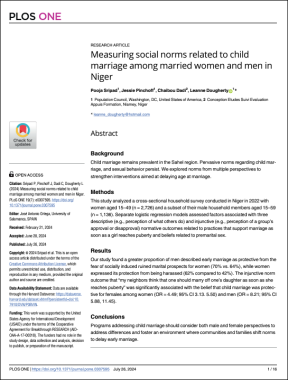Here are some useful resources on research tools to help you understand social norms on child marriage, and to monitor and evaluate any changes in those norms:
What are social norms? How are they measured? by Mackie (2015) is a ‘primer’ on definitions and measures of social norms based on a review of 173 publication. It discusses how to measure social norms, providing answers from the perspective of different approaches to conceptualising norms.
CARE’s Social Norms Analysis Plot (SNAP) was developed to measure the influence of specific norms and offers a useful framework to examine the preliminary effects of activities designed to change norms. It focuses on changes in empirical expectations (‘what I think others do’), normative expectations (‘what I think others expect me to do’), on sanctions (‘how I think others will react’), sensitivity to sanctions (‘how much sanctions matter to me’), and exceptions (‘circumstances under which it is acceptable to break with norms’). Applying theory to practice: CARE’s journey piloting social norms measures for gender programming describes how the SNAP approach was developed. Robust and easy to use, SNAP has been used for formative, baseline and endline research and is summarised in CARE’s methods brief and in the full report.
Resources produced as part of ODI’s Transforming the Lives of Adolescent Girls project include:
- Question guide: researching norms about early marriage and girls’ education. This outlines the key qualitative tools used to investigate gender norms, focusing on child marriage and education. Tools include body mapping, key informant interviews, focus group discussions, intergenerational trios, and outlier case studies. These tools can be used with adolescent girls and boys, with parents and in-laws, and with key informants such as government officials and programme implementers.
- What can internationally comparable quantitative data tell us about how gender norms are changing? explains how data collected regularly – such as demographic and health surveys (DHS), multiple indicator cluster surveys (MICS) and World Values surveys, among others – can reveal important insights in how gender norms that affect adolescent girls are changing.
- Changing Gender Norms: monitoring and evaluating programmes and projects outlines some indicators of child marriage and links to studies where these indicators have been used; many also include the survey questions used (Table 1, page 9).
- How useful are systematic reviews for evaluating gender norm change interventions? has useful information on monitoring indicators around practices, behaviours, attitudes and perceptions in different areas of girls’ lives (Table 2, page 7).
The Gender-Equitable Men Scale (GEMS) measures men’s attitudes to gender equality and can also be used to measure the effectiveness of programmes designed to influence norms. Although it does not refer explicitly to child marriage, it examines gender norms around sexuality, gender roles, and reactions to non-conformity. Though GEMS was developed for use with young men in low-income communities, it has been successfully adapted for use with a variety of age groups, with women and girls, and in middle- and high-income communities, so could be adapted further to be relevant to child marriage.
Cristina Bicchieri of the University of Pennsylvania has made a significant contribution to work on social norm change, including applying social norms theory to the challenge of monitoring changes in norms related to collective practices. In A structured approach to a diagnostic of collective practices, Bicchieri and colleagues present a theoretical framework to guide the measurement of social norms around child marriage. In particular they advocate the use of vignettes to understand norms around child marriage.
Social Network Analysis. Social network analysis can be used to map reference groups and understand the key influencers of decision-making about child marriage. Bettina Shell-Duncan, Amadou Moreau, Sarah Smith and Holly Shakya outline a qualitative approach to understanding social networks of influence around about female genital cutting/ mutilation. It could easily be adapted to probe norms about child marriage.
Factorial focus groups. Shell-Duncan et al’s paper, and this report for the Population Council Nairobi also outlines ‘factorial focus groups’, which structure focus groups to enable comparison of different influences on norms and behaviour. This approach is easily adaptable to explore norms around child marriage.
The Child Marriage Acceptability Index is a tool developed by Plan International to measure changes in knowledge and attitudes (rather than behaviours and practices). It consists of 23 statements that respondents are asked to agree or disagree with, using a seven-point Likert scale. A user guide and data collection tools are available.
SenseMaker is a research tool that involves collecting and analysing a large number of brief narratives (stories) that can be used to assess programme impact. It is a way of meta analysing qualitative data – individual people’s stories – in which respondents apply a framework for signification (interpretation) of their story. Statistical software is then used to analyse the stories; this methodology is useful for enabling quick recognition of patterns, as well as identifying shifts or deviations from the norm. CARE’s Tipping Point project adapted the methodology to promote learning and build capacity at the local level, creating opportunities for review and reflection with project field staff – for example, engaging them as ‘knowledge workers’ who could provide insights to inform programme design.
The Voices for Change programme (V4C) in Nigeria has produced a legacy paper about the methods it used to track social norms. It used a bespoke Attitudes, Practices and Social Norms (APSN) survey to focus on norms around violence against women, but the survey can also be adapted to investigate other issues.
- Tags:
- Child marriage
- Countries / Regions:
- Global
Related resources
Journal article
26 Julio 2024

Report
8 Mayo 2024

Report
22 Febrero 2024
